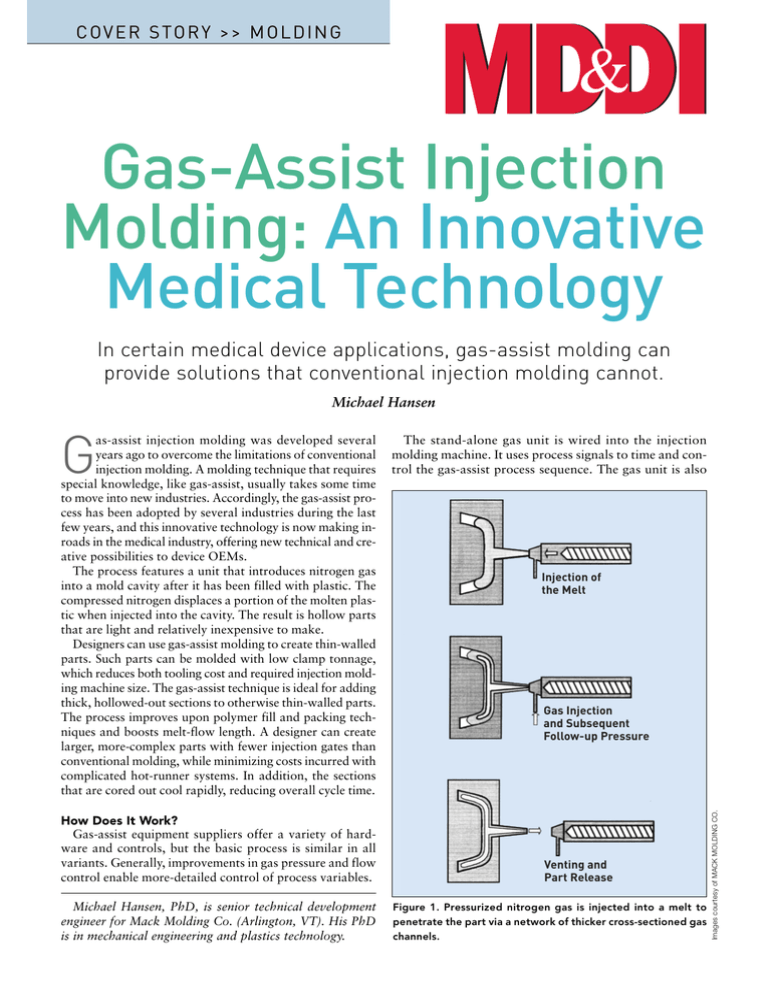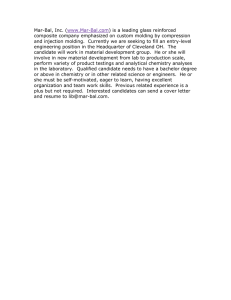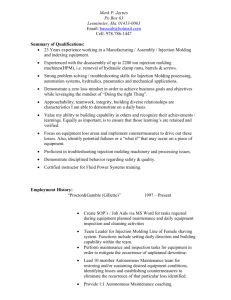Gas-Assist Injection Molding: An Innovative Medical
advertisement

C OV E R S TO R Y > > M O L D I N G Gas-Assist Injection Molding: An Innovative Medical Technology In certain medical device applications, gas-assist molding can provide solutions that conventional injection molding cannot. Michael Hansen G How Does It Work? Gas-assist equipment suppliers offer a variety of hardware and controls, but the basic process is similar in all variants. Generally, improvements in gas pressure and flow control enable more-detailed control of process variables. Michael Hansen, PhD, is senior technical development engineer for Mack Molding Co. (Arlington, VT). His PhD is in mechanical engineering and plastics technology. The stand-alone gas unit is wired into the injection molding machine. It uses process signals to time and control the gas-assist process sequence. The gas unit is also Injection of the Melt Gas Injection and Subsequent Follow-up Pressure Venting and Part Release Figure 1. Pressurized nitrogen gas is injected into a melt to penetrate the part via a network of thicker cross-sectioned gas channels. Images courtesy of MACK MOLDING CO. as-assist injection molding was developed several years ago to overcome the limitations of conventional injection molding. A molding technique that requires special knowledge, like gas-assist, usually takes some time to move into new industries. Accordingly, the gas-assist process has been adopted by several industries during the last few years, and this innovative technology is now making inroads in the medical industry, offering new technical and creative possibilities to device OEMs. The process features a unit that introduces nitrogen gas into a mold cavity after it has been filled with plastic. The compressed nitrogen displaces a portion of the molten plastic when injected into the cavity. The result is hollow parts that are light and relatively inexpensive to make. Designers can use gas-assist molding to create thin-walled parts. Such parts can be molded with low clamp tonnage, which reduces both tooling cost and required injection molding machine size. The gas-assist technique is ideal for adding thick, hollowed-out sections to otherwise thin-walled parts. The process improves upon polymer fill and packing techniques and boosts melt-flow length. A designer can create larger, more-complex parts with fewer injection gates than conventional molding, while minimizing costs incurred with complicated hot-runner systems. In addition, the sections that are cored out cool rapidly, reducing overall cycle time. MOLDING >> Solidified Layer Hot Core Prefill with Melt Expanding Gas Bubble PGas Gas Injection Phase Solidified Layer PGas Cooling after Gas Injection Figure 2. During melt and gas injection, some of the polymer melt solidifies at the outer wall and forms a solid layer of resin. linked to a nitrogen source (e.g., bottles, a liquid nitrogen tank, or a nitrogen generator). The nitrogen source can be located close to the gas unit or can be part of a central plant system. The gas can be injected into the polymer melt either through a molding machine nozzle or through a gas nozzle. With a machine nozzle, the nitrogen gas flows through sprue, runners, and gates before entering the part. With a gas nozzle, the gas flows directly into the part. The Process Sequence Figure 1 shows the principal gas-assist process sequence. Pressurized nitrogen gas injected into the melt penetrates the part via a network of thicker, cross-sectioned gas channels. The process can accomplish partial or volumetric fillings of a cavity with polymer melt, as in injection molding. Next is the injection of compressed gas. Nitrogen is usually used because of its availability, cost, and inertness. Some processes will, in addition, use overspill cavities for structural or cosmetic reasons. Some resins require a complete filling of the tool prior to applying the gas to produce cosmetically acceptable parts.1,2 After the gassing phase, the pressure is released either by gas recycling or by releasing the gas into the atmosphere. As soon as ambient pressure is reached, the molded part can be ejected. Figure 2 illustrates the process of forming a part using gasassist molding. During melt and gas injection, some of the polymer melt solidifies at the outer walls and forms a solid layer of resin. This layer grows during the delay between the polymer and gas injection. During gas injection, the compressed nitrogen flows through the plastic core and displaces a portion of the molten plastic. Normally, after plastic is injected and fills the cavities, the molding machine goes into a packing stage to prevent void formation. With gas-assist molding, the gas performs the packing, and the voids are intentionally created to reduce part weight and minimize cycle time. Nitrogen gas has a lower viscosity than the polymer melt. For this reason, the pressure drop over the flow length of the gas bubble is much lower than over the flow length of a molded part. The pressure drop in the holding and packing phase influences the shrinkage across the part and the ability to pack a part. Shrinkage differences promote buildup of internal molded-in stresses and subsequently influence the warpage of a part significantly. The gas-assist process reduces internal stresses and warping and thus improves part quality. It provides a higher and more evenly distributed packing pressure across the part, resulting in better overall part flatness. Gas always takes the path of least flow resistance; it flows into the direction of the melt front. The gas channel’s course goes through the cores of thicker or hotter portions of the part. The advancing gas pushes the displaced molten plastic toward the melt front to fill and later pack those areas in the cavity. After a complete volumetric filling of the cavity, the gas pressure replaces the holding pressure, which compensates for the shrinkage. The internal gas pressure keeps the part in good contact with the mold walls. The hotter melt core of the part has the most shrinkage potential, and because of the applied gas pressure, the cooling melt shrinks the most in the hot core section. The shrinkage becomes less toward the mold wall. At the tip of the gas bubble, a so-called shrinkage lance forms because of the differential shrinkage in different layers over the cross section of the part. The lance prevents the molded part from sinking in. Figure 3 illustrates the machine cycle of the gas-assist process. It’s important to note the efficiencies that can be gained using this process. First, gas-recycling technology is Begin Cycle Part Ejection Open Mold Close Mold Unit Forward Resin Injection Delay Time Remaining Cooling Time Gas Injection Phase Unit Back Gas Pressure Holding Phase Gas Pressure Release Figure 3. Machine cycle of the gas-assist injection process. MOLDING >> • Full-shot molding that pushes resin back into barrel (similar to the overspill technique using the machine barrel as the overspill cavity). • External gas molding (adding a layer of nitrogen gas to the part surface adjacent to the cosmetic surface after complete fill of the cavity). (a) Rod-Shaped Parts (b) Large Cover-Shaped Parts (c) Complex Parts with Localized Heavy Sections Figure 4. Three main categories of molded parts are especially appropriate for gas-assist injection molding. fully developed and can be used in production, thereby reducing costs. Also, when gassing through the machine nozzle (rather than directly into the part), the runner system can be sealed after pressure release. During the remaining cooling time, the injection unit meters the shot size for the next cycle, which reduces cycle time. Many part designers still see the gas-assist process as a solution only for simple, hollow, tube-shaped parts. In practice, however, it is much more versatile and can often solve many of the problems inherent in conventional injection molding. Some of the benefits include thin-walled parts and fast cooling for reduced cycle times. Less required clamp tonnage means smaller molding machine size. In addition, gas-assist molding minimizes tooling costs and can make large, complex parts using fewer gates and less-complicated hot-runner systems than traditional machines. There are different gas-assist injection molding techniques, including the following: • Short-shot molding (prefill of cavity with melt, followed by gas injection). • Full-shot molding (complete fill of cavity with melt, followed by gas injection). • Full-shot molding with overspill (complete fill of cavity with melt, followed by gas injection and opening of overspill cavities). In addition, there are variants of these techniques. One includes a process that uses low-temperature nitrogen gas to create a gas flow through the part for an additional cooling effect. For some resins, the short-shot method cannot be used because of cosmetic surface requirements. Full-shot processes that have additional cavities into which the resin in the core is evacuated generally provide more control over the process. Geometric Categories Three main categories of molded parts are especially appropriate for gas-assist technology. The first group—tubeor rod-shaped parts—typically includes handles and foot pedals (see Figure 4a). The second category consists of large, cover-shaped structural parts. Such parts are made with a network of gas channels that is often combined with the rib structure of the parts. Examples include side panels and covers for medical devices (see Figure 4b). The third group involves complex parts with both thin and thick sections. The gas-assist process is used for part integration by consolidating several assembled parts into a single design (Figure 4c). Typical examples would be handles with mounting sections or tray-like parts with thick perimeter sections. Because the flow path for tube- or rod-shaped parts is one-dimensional, a good distribution of the gas channel can be ensured. With these parts, uniform wall thickness It is very important to understand and appropriately design the filling pattern before injecting the gas. The design should be adapted according to the planned or existing gas channel network. throughout the cross section is the goal. The resulting wall thickness is a function of the viscosity and temperature distribution within the melt when the nitrogen gas is injected. For extended thin-walled parts, the desired distribution of nitrogen gas can only be achieved through a geometrical adaptation. These parts require some ribbing to create a network of gas channels. Injecting nitrogen during the gassing and holding phases of the process forms the hollow spaces. Ultimately, the process produces parts with reduced internal stresses and, consequently, less warpage. Gas penetration into the adjacent thin-wall sections should be avoided. It is MOLDING >> Process Parameters • Delay Time • Gassing Time • Gas Profile • Degree of Prefill • Melt/Mold Wall Temperature Material Data • Rheological Behavior • Thermal Behavior Machine Data Part • Geometry Categories • Injection Point Location • Part Design Process Analysis • Mathematical Modeling • Experiments • Finite Element Methods • Gassing Position/Location • Concept of Gassing Unit • Gas Profile • Process Variant Figure 5. Five important factors influence the production of gas-assist-injection-molded parts. Figure 6. Using gas-assist molding ensured consistent wall thicknesses over the length of Alcon’s Infiniti main handle. Figure 7. The gas evenly hollowed out the Infiniti’s side handle. It is a closed-loop part, so overspill technology was required. possible to determine the probability of gas penetration into adjacent wall sections by examining part design, gas channel geometry, the relation of wall thickness to gas channel dimensions, and the gas pressure itself. It is also very important to understand and appropriately design the filling pattern before injecting the gas. The design should be adapted according to the planned or existing gas channel network. The gas channel layout depends on the size, shape, course, and length of the gas channels. It also depends on the location of the injection points and geometry and the needle position for gassing. Manufacturers can obtain this information through iterative testing or by using mold-filling simulation programs. Here, the processing parameters, as well as rheological and thermal behavior of the polymer, are very important. Optimizing Parts and Tool Design Five significant factors influence the production of gasassist-injection-molded parts (see Figure 5). These factors and their interdependencies are the most important checkpoints for part and tool design. It is critical to adapt part design to the gas-assist injection molding process. It is essential to take the specific processing requirements and conditions into account in the early stages of part concept and design. Doing so can reduce the necessary adaptation work to a minimum. Application Examples In the following examples, parts fall within one of the three categories shown in Figure 4. MOLDING >> Gas-Assist Handles with Attached Thinner Sections. Because of the thick cross section of the molded handles, a gas-assist process is used to mold a hollow, tube-shaped part with a highly cosmetic surface and a consistent internal gas channel. The molding process ensures mechanical and structural integrity. Figure 6 shows the Infiniti main handle by Alcon Laboratories (Irvine, CA). The handle is sectioned to show the hollowed out center in its tube-shaped portion. It is important to note that the wall thickness is consistent over the length of the handle and around its perimeter. This optimizes the mechanical Figure 8. To make a Datascope main handle, a number of gas nozzles were timed to properties of the molded part. control the introduction of the gas in different locations. Thin-walled, ribbed mounting sections located at both ends of the handle mean that the handle could be attached to the main unit. The Alcon handle needed high structural strength combined with impact resistance requirements and good cosmetic surface finishes. These specifications required overspill technology. The part is completely filled and packed prior to using nitrogen gas to push the hot melt into an additional cavity. The Alcon Infiniti side handle in Figure 7 is cut open through the entire length of the part, illustrating the extent to which the gas evenly hollowed out the cavity. The part needed to meet the same design requirements as the main handle. Because the side handle is designed as a closed-loop part, the same overspill technology was required. The main handle by Datascope (Montvale, NJ) shown in Figure 9. This keyboard for Philips Medical Systems combines Figure 8 is an example of a gas-assist molded part consista thick-walled injection-molded part with attached handles. ing of a closed-loop handle with thinner attached portions. Some of the cross sections’ walls are more than 1.5 in. thick. Again, the nature of the design required the use of overspill technology. The challenge with this part was hollowing out a thick closed-loop section, which was split up into different channels. This required placing a number of gas nozzles within the tool. The nozzles were carefully timed to control the introduction of the nitrogen gas in different locations. The result is a highly structural, tubular part. Gas-Assist Structural Parts Featuring Thicker Sections and a Handle. The keyboard part for a medical application made by Philips Medical Systems (Andover, MA), shown in Figure 9, combines a thick-walled injection-molded part with attached handles. It also features built-in thickwall part details and a tubular cross section perimeter detail. The thick tubular sections are primarily located on the perimeter of the part, making it a complex application from a processing perspective. Again, the challenge was Figure 10. The gas channels ensured that the gas hollowed out placing the gas nozzles in the appropriate locations, based and packed the base of the bosses on a clamshell for Zoll. on the filling pattern, to create hollow sections. The cross MOLDING >> sections in some areas are close to 2 in., making straight injection molding economically impossible. Gas-Assist Overmolded Parts with Localized Gas Channels. The image in Figure 10 illustrates the top and bottom assembled parts for the clamshell of an overmolded automated external defibrillator made by Zoll Medical Corp. (Chelmsford, MA). The design required high mechanical structural integrity, impact resistance, and good functionality. The image shows the upper and lower housing parts of the device, which are attached to each other with a screw/boss design. A screw/boss design is a method for assembling two parts by ultrasonically welding or heat staking a metal insert into a hollow plastic part. A screw threads into the metal insert and mechanically interlocks both parts. Gas channels in each part, top and bottom, were located on both corners of the cut. The bosses on the lower part created thick sections, which were hollowed out prior to overmolding to avoid sink marks on the substrate part. The gas channels were strategically placed in localized areas close to the mass accumulations of material. The gas channels ensured that nitrogen gas hollowed out and packed the bottom of the bosses. The resulting surface was free of sink marks for the subsequent processing step. On the upper half of the clamshell design, the gas next to the coring helped to minimize part warpage. That was especially important in the opening for the battery door. Placement of the gas nozzles and the processing conditions for the gas were important considerations. The part was completely filled prior to gas injection. Nitrogen gas replaced packing pressure and ensured that certain areas with mass accumulations were hollowed out and packed. Using gas-assist technology also enabled molding with minimum warpage, which was important for the subsequent processing steps. Conclusion Gas-assist injection molding technology has evolved to include many different techniques. The process offers numerous possibilities for designing parts with thick sections, such as handles, as well as parts with localized thick areas or other part features. Without gas-assist technology, many of these features could not be incorporated into part design because of economic, functional, or tooling reasons. Enhancing design capability enables gas-assist technology to directly contribute to the success of medical device manufacturing. Gas-assist technology has proven to be, and will continue to be, a viable tool to provide manufacturing solutions that will help bring new products to market quickly and economically. References 1. Hansen, Michael. “Application Examples for Gas-Assisted Injection Molded Parts,” in Proceedings of the SPE Structural Plastics Division Conference. Boston: Society of Plastics Engineers, 1999. 2. Hansen, Michael. “Processing Basics for the Design of Gas-Assisted Injection Molded Parts,” PhD thesis. Aachen, Germany: Shaker Publishers, 1996. ■ Reprinted from Medical Device & Diagnostic Industry, August 2005, Copyright © 2005 Canon Communications LLC




